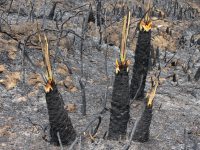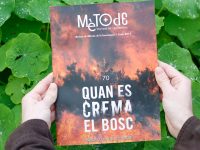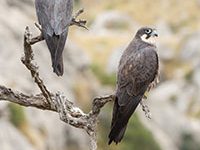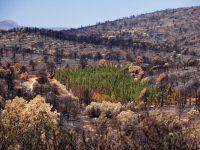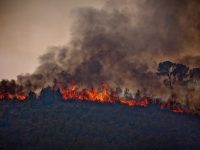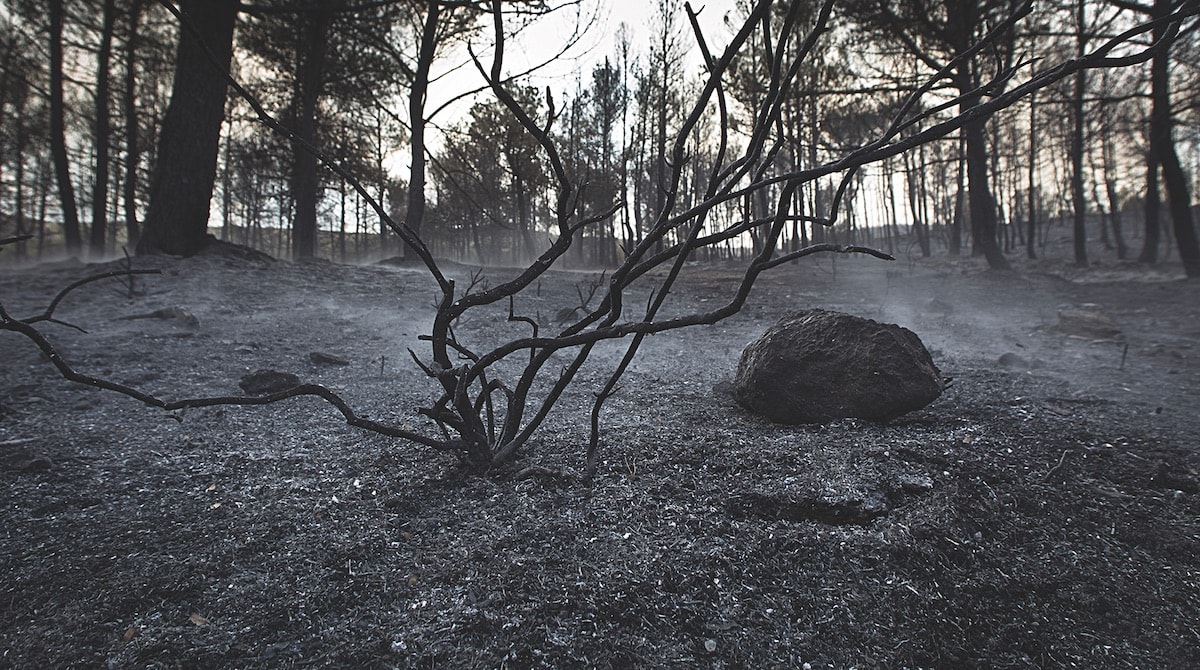
After a forest fire, the immediate negative impact is all too plain to see. We ask ourselves whether natural populations, abiotic properties and the economy and society in the affected area will recover over time. This question comes up after each wildfire but to answer it is complex.
The climate in the Mediterranean Basin is characterised by warm autumns and relatively wet springs and hot dry summers. During the latter season there is a high rate of naturally caused fires, due to dry storms. Furthermore, the Mediterranean Basin has been inhabited by man since the sixth century BC with highly evolved socialised civilisations that have transformed the natural landscape. Fire was one of the main tools used by these societies. Indeed, dating shows fire was used for agricultural purposes and animal husbandry some 10,000 years ago or more. This tool is so widespread that, together with the frequent fires of natural origin, it has shaped the landscape and ecosystems to such an extent that they have either managed to adapt or they have disappeared. Thus, Mediterranean ecosystems recover pre-fire characteristics quickly (taking a few years or decades), while other ecosystems take significantly longer and others still never recover.
«Nowadays, fires are a problem in Europe, where 50,000 fires occur yearly, destroying vast areas of forest and other rural areas»
Nowadays, wildfires are a problem in Europe, where some 50,000 occur yearly destroying vast areas of forest and other rural lands. This problem is aggravated in the Mediterranean region, where nearly 500,000 hectares burn per year. Between 1980 and 2008, in Spain, Portugal, France, Italy and Greece alone over fourteen million hectares were scorched, equivalent to a surface area larger than Greece. This represents an increase, caused by global change-related factors that are altering the natural fire dynamics in the Mediterranean area. Studies show that modified land use and climate change affect the characteristics of fires, leading to an increase in recurrence (shorter time lapse between fires), intensity (the fire releases a greater amount of energy), severity (more organic matter is consumed), risk of ignition (greater accumulation of brushwood), risk period (which is almost all year round rather than just in summer), burned surface area (larger extensions are burned by a few fires) and larger fires exceeding 500 hectares.
«Climate change is directly affecting ecosystems, for instance, by depletion of nutrients and of water availability or changes in the behaviour of pollinators or pests»
What is more, climate change is directly affecting ecosystems, for instance by depletion of nutrients and of water availability or changes in the behaviour of pollinators or pests. These factors together are affecting an increasingly large forestland area, whose resilience decreases, increasing the areas at risk, which reduces the chances of natural recovery occurring after wildfire or another kind of disturbance. However, a large part of our ecosystem remains responsive and is able to recover and, thanks to this, vegetation grows back quickly, which strongly influences the recovery of other communities in the ecosystem and certain abiotic properties. This has valuable socio-economic repercussions, although the opposite may occur since poor recovery may reduce or even aggravate the socio-economic losses caused by the initial disturbance.
Perhaps that is why we presuppose our ecosystems to have an eternal self-renewal capacity, but this is not the case. Such recovery may not follow the initial floristic model and we end up losing an ecosystem representative of an area. Therefore, our forests and natural areas –as we know them– may disappear because they fail to adapt or have low resilience to heat, or because some of the aforementioned changes deteriorate and weaken the forestlands. Such loss leads to the impairment of other elements in the ecosystem, which in the short term directly –and principally– affects animal communities and soil richness. Because of all this, prevention and restoration of affected or high-risk areas start with the main plant species that make up the ecosystem, and in the long-term unite preventive and restorative measures.
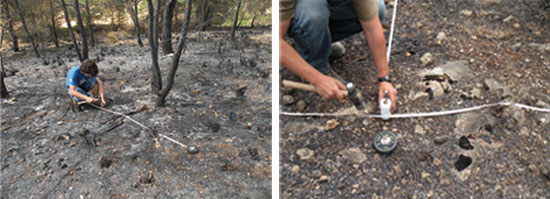
After a fire, the burned area must be monitored on an ongoing basis to assess the potential action to be taken. The picture shows transects being prepared to study the severity of the fire in a Mediterranean pine forest a week after an area burned in the south-eastern Iberian Peninsula. / Daniel Moya, UCLM
Are all fires a disaster?
The first step in performing a task aiming to prevent the ecosystem from disappearing, either proactively or by restoring a burned area, is to take into account that not all forest fires are a disaster for the environment or the landscape. As mentioned before, the Mediterranean climate and wildfire are inseparable, so to strive to bring the number of fires down to zero is utopian. Should this occur, it would reshape today’s Mediterranean landscape and ecosystem.
Depending on when fire occurs, its extent, intensity and severity, the ecosystem will respond differently, giving rise to situations that could lead to an improvement in its state prior to the fire. One only has to look at the low negative impact caused by fires of low to medium intensity and severity, covering small areas and occurring in periods of non vegetative-growth (summer or winter). In fact, they even produce positive short-term effects, such as adding nutrients to the soil or opening up clearings, thus promoting the renewal of vegetation and attracting new species. This leads to an increase and improvement in plant diversity, landscape and fauna. In these cases, and if there is no risk of new fires in the same affected area, non-intervention is the best management option, in other words, to do nothing. What is more, in certain protected areas the natural fire regime has declined so much that there are unstable situations. In these cases controlled burning with the above-described characteristics could be useful to prevent serious wildfires and improve the ecosystem.
«There are three main policies: active restoration of the ecosystem, assisting natural recovery or non-intervention»
In order to forecast the ultimate damage a fire can cause in an area and apply the appropriate intervention measures, spatial planning should consider the vulnerability of ecosystems and landscapes to fire and its recurrence. This is especially true of environmental or conservation plans for forest management in areas of special interest or subject to some degree of risk. If there were such plans, prevention policies would be much more effective and would provide an action plan to be followed in the event of fire. Meanwhile, after a fire has occurred, a follow-up study should be made of the area, analysing the severity of the fire and the ecosystem response. To implement a restoration plan catering to specific needs, there are three main policies: 1) active restoration of the ecosystem; 2) assisted natural recovery; 3) non-intervention. The latter option should be considered in those ecosystems with low risk and high resilience levels, especially in the case of low or medium intensity fire affecting a small surface area. If vegetation recovers rapidly, with the appearance of new buds sprouting, then the risk of runoff and soil loss is not high. Otherwise, emergency treatment should be taken to mitigate land degradation and severe runoff. Numerous studies show that logging and removal of dead wood in the burned area cannot be recommended for at least the first two years after the fire. This is because damage to the soil, seed bank and possible natural regeneration underway at the time may prove fatal to the recovery of the ecosystem. If such action is necessary, environmentally-friendly procedures are recommended, with the use of overhead extraction methods and light-weight forestry equipment to avoid soil compaction and damage. Scattered dead tree trunks should always be left to serve as a shelter for birds, small mammals and insects, thus creating a so-called wildlife effect, and improving animal diversity.
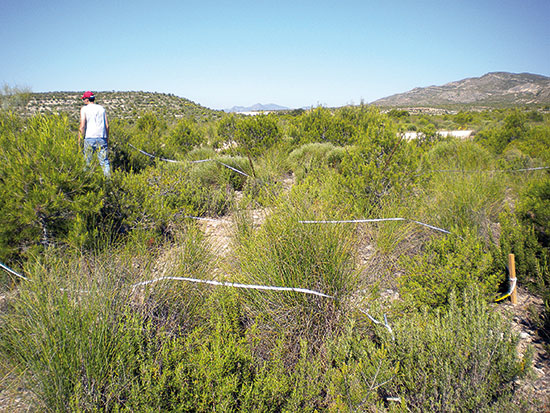
The area must be monitored both short and long term. The images show different ways to assess and quantify the state of natural recovery of a Mediterranean pine forest fifteen years after a fire. / Daniel Moya, UCLM
Assisting natural recovery
After a fire, the affected area should be continuously monitored, both short and medium term, to get the information to help take decisions. High natural regeneration can cause long-term problems due to excessive densities of some highly competitive species, which would lead to changes in the line of succession common to the area. In this case, natural regeneration should by artificially assisted using forest management tools to cope with the new situation, which may be expected due to climate change and its impact on fire regimes. Thus, timely reduction of the density of the main species through selective thinning can reduce both inter and intra-species competition. This would allow a more efficient use of available resources (light, water and nutrients) by autotrophic organisms, which would –a priori– help increase primary productivity of the ecosystem. At the same time, and at relatively low direct costs, the quantity and continuity of brushwood is minimised and biodiversity is enhanced by opening clearings, thereby increasing ecosystem resilience. Depending on the ecosystem, other measures may be applied, such as grazing, creating preventative and protective plant barriers to promote landscape heterogeneity, helping to reduce the risk of fire, to raise ecosystem resilience and reduce the affected area in the event of fire.

Photo: Daniel Moya, UCLM
Active ecosystem restoration
If monitoring indicates there are problems with natural regeneration, then active reforestation approaches and afforestation techniques should be implemented in the affected area. Urgent action should never be taken but rather it should be planned to restore and enhance the ecosystem. In this respect, reforestation has often been performed which –due to the selected species, treatment, or the tools used– has led to the impoverishment of the area. In such cases, inaction would have been preferable despite the possible need to introduce or encourage the growth of a forest tree species. Thus, we find –too often– the planting of tree species which cannot establish themselves simply because the soil and/or climate are not suitable. In some cases, even undergrowth, brush and grasses are removed from the area in the preparatory work, which causes loss and degradation of both soil and plant diversity. This, in turn, leads to the loss of scenic value and diminishes the variety of fauna. Therefore, planning of the work to be carried out is essential and the species to be introduced or encouraged must be carefully chosen. Whenever possible, it is preferable to plant seeds of potential species in the area, which are highly resilient. If reforestation is carried out with seedlings or plants, one should consider the possibility of introducing mycorrhizal species to increase the growth and vigour of the former, and to enrich the ecosystem. The choice of species should be consistent with the state of degradation in the area concerned as well as taking into account predictions for global change. Native species that are highly resistant and resilient to fire should be used. Repopulation could even be done with bushes should conditions dictate. If possible, it would also be interesting to create «patches» that break up continuity, introducing other species that produce low-intensity heat when burned. These could serve as «live firebreaks», as well as improving biodiversity and landscape quality.
«Depending on the ecosystem, different protection and prevention measures may be applied»
Altogether, these measures enable us not only to recover and rehabilitate the affected areas but, also, to take advantage of the opportunity fire provides for landscape management and planning. Thus, more varied landscapes can be achieved, including areas that would reduce the intensity of eventual fire, and which could be used as natural firebreaks due to the characteristics of the species growing there or to silvicultural management, used to keep fuel densities and load down. Ecosystems adapted to the area in which they are located should be maintained, preventing soil degradation and pollution of both surface waters and groundwater. Planning should also include provision for projected climate changes in the area, as they may affect the health status or vigour of the new forests growing there. Accordingly, we must implement and improve on traditional management tools to address these issues, creating more resilient ecosystems, as climate change is not just a change in itself but also implies other related changes, such as fire dynamics.
REFERENCES
Cerdà, A. & J. Mataix-Solera (eds.), 2009. Efectos de los incendios forestales sobre los suelos en España. El estado de la cuestión visto por los científicos españoles. Càtedra de Divulgació de la Ciència. Universitat de Valencia. Valencia.
Rodrigo, A., Retana, J. & F. X. Picó, 2004. «Direct Regeneration Is Not the Only Response of Mediterranean Forests to Large Fires». Ecology, 85 (3): 716-729.
Trabaud, L. & R. Prodon,1993. Fire in Mediterranean Ecosystems. CEC. Brussels.

